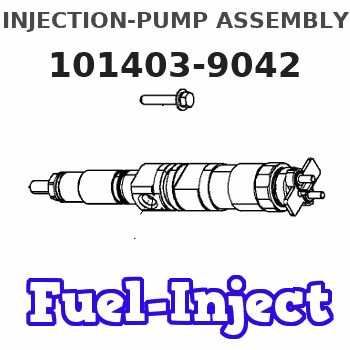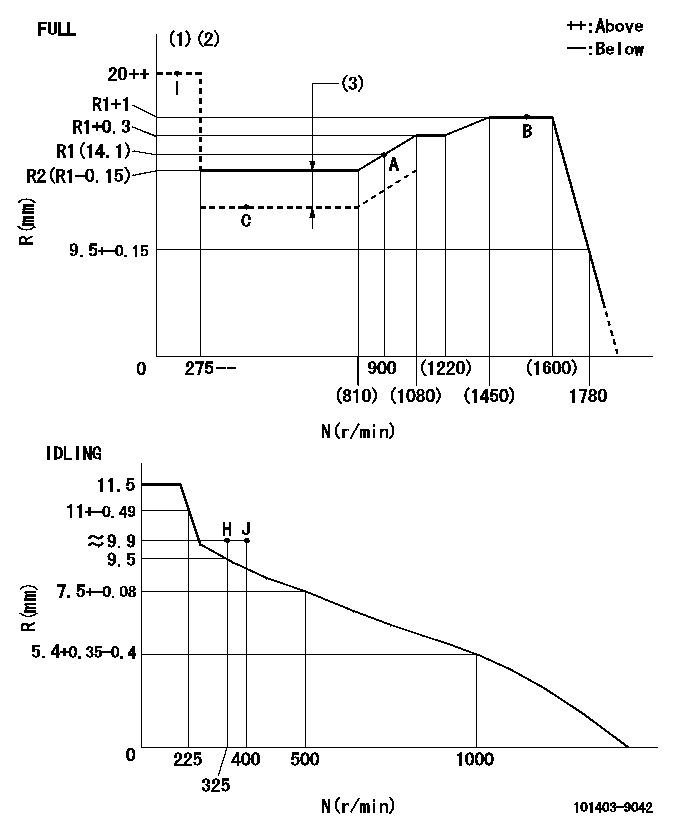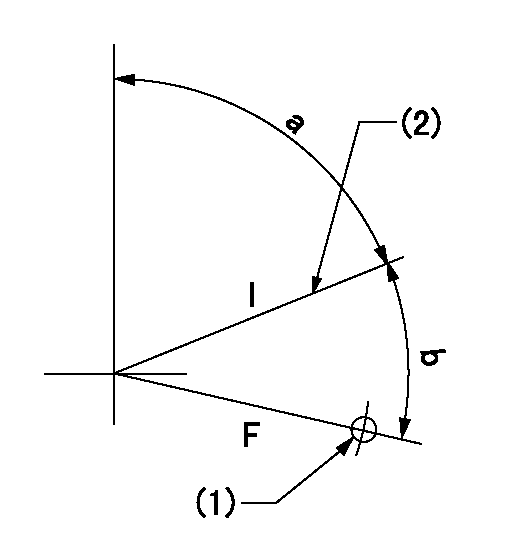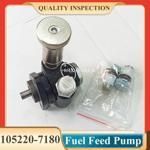Information injection-pump assembly
BOSCH
9 400 612 108
9400612108
ZEXEL
101403-9042
1014039042
NISSAN-DIESEL
1670019D21
1670019d21

Rating:
You can express buy:
Service parts 101403-9042 INJECTION-PUMP ASSEMBLY:
1.
_
6.
COUPLING PLATE
7.
COUPLING PLATE
8.
_
9.
_
11.
Nozzle and Holder
16600-19D20
12.
Open Pre:MPa(Kqf/cm2)
19.6{200}
15.
NOZZLE SET
Cross reference number
BOSCH
9 400 612 108
9400612108
ZEXEL
101403-9042
1014039042
NISSAN-DIESEL
1670019D21
1670019d21
Zexel num
Bosch num
Firm num
Name
101403-9042
9 400 612 108
1670019D21 NISSAN-DIESEL
INJECTION-PUMP ASSEMBLY
FD46TA K 14BD INJECTION PUMP ASSY PE4AD PE
FD46TA K 14BD INJECTION PUMP ASSY PE4AD PE
Calibration Data:
Adjustment conditions
Test oil
1404 Test oil ISO4113 or {SAEJ967d}
1404 Test oil ISO4113 or {SAEJ967d}
Test oil temperature
degC
40
40
45
Nozzle and nozzle holder
105780-8140
Bosch type code
EF8511/9A
Nozzle
105780-0000
Bosch type code
DN12SD12T
Nozzle holder
105780-2080
Bosch type code
EF8511/9
Opening pressure
MPa
17.2
Opening pressure
kgf/cm2
175
Injection pipe
Outer diameter - inner diameter - length (mm) mm 6-2-600
Outer diameter - inner diameter - length (mm) mm 6-2-600
Overflow valve
134424-4120
Overflow valve opening pressure
kPa
255
221
289
Overflow valve opening pressure
kgf/cm2
2.6
2.25
2.95
Tester oil delivery pressure
kPa
255
255
255
Tester oil delivery pressure
kgf/cm2
2.6
2.6
2.6
Direction of rotation (viewed from drive side)
Right R
Right R
Injection timing adjustment
Direction of rotation (viewed from drive side)
Right R
Right R
Injection order
1-3-4-2
Pre-stroke
mm
3.2
3.15
3.25
Rack position
Point A R=A
Point A R=A
Beginning of injection position
Drive side NO.1
Drive side NO.1
Difference between angles 1
Cal 1-3 deg. 90 89.5 90.5
Cal 1-3 deg. 90 89.5 90.5
Difference between angles 2
Cal 1-4 deg. 180 179.5 180.5
Cal 1-4 deg. 180 179.5 180.5
Difference between angles 3
Cyl.1-2 deg. 270 269.5 270.5
Cyl.1-2 deg. 270 269.5 270.5
Injection quantity adjustment
Adjusting point
-
Rack position
14.1
Pump speed
r/min
900
900
900
Average injection quantity
mm3/st.
100
98.4
101.6
Max. variation between cylinders
%
0
-3.5
3.5
Basic
*
Fixing the rack
*
Standard for adjustment of the maximum variation between cylinders
*
Injection quantity adjustment_02
Adjusting point
H
Rack position
9.9+-0.5
Pump speed
r/min
325
325
325
Average injection quantity
mm3/st.
13
11.2
14.8
Max. variation between cylinders
%
0
-10
10
Fixing the rack
*
Standard for adjustment of the maximum variation between cylinders
*
Injection quantity adjustment_03
Adjusting point
A
Rack position
R1(14.1)
Pump speed
r/min
900
900
900
Average injection quantity
mm3/st.
100
99
101
Basic
*
Fixing the lever
*
Boost pressure
kPa
59.3
59.3
Boost pressure
mmHg
445
445
Injection quantity adjustment_04
Adjusting point
B
Rack position
R1+1
Pump speed
r/min
1500
1500
1500
Average injection quantity
mm3/st.
115.5
111.5
119.5
Fixing the lever
*
Boost pressure
kPa
59.3
59.3
Boost pressure
mmHg
445
445
Boost compensator adjustment
Pump speed
r/min
600
600
600
Rack position
R2-1.6
Boost pressure
kPa
14
12.7
15.3
Boost pressure
mmHg
105
95
115
Boost compensator adjustment_02
Pump speed
r/min
600
600
600
Rack position
R2(R1-0.
15)
Boost pressure
kPa
46
46
46
Boost pressure
mmHg
345
345
345
Timer adjustment
Pump speed
r/min
780--
Advance angle
deg.
0
0
0
Remarks
Start
Start
Timer adjustment_02
Pump speed
r/min
730
Advance angle
deg.
0.5
Timer adjustment_03
Pump speed
r/min
1550
Advance angle
deg.
5.7
5.2
6.2
Timer adjustment_04
Pump speed
r/min
-
Advance angle
deg.
7
6.5
7.5
Remarks
Measure the actual speed, stop
Measure the actual speed, stop
Test data Ex:
Governor adjustment

N:Pump speed
R:Rack position (mm)
(1)Torque cam stamping: T1
(2)Tolerance for racks not indicated: +-0.05mm.
(3)Boost compensator stroke: BCL
----------
T1=N79 BCL=1.6+-0.1mm
----------
----------
T1=N79 BCL=1.6+-0.1mm
----------
Speed control lever angle

F:Full speed
I:Idle
(1)Use the hole at R = aa
(2)Stopper bolt set position 'H'
----------
aa=32mm
----------
a=71.5deg+-5deg b=40deg+-3deg
----------
aa=32mm
----------
a=71.5deg+-5deg b=40deg+-3deg
Stop lever angle

N:Pump normal
S:Stop the pump.
(1)Use the pin at R = aa
----------
aa=15mm
----------
a=29deg+-5deg b=10deg+-5deg
----------
aa=15mm
----------
a=29deg+-5deg b=10deg+-5deg
Timing setting

(1)Pump vertical direction
(2)Position of gear's standard threaded hole at No 1 cylinder's beginning of injection
(3)B.T.D.C.: aa
(4)-
----------
aa=8deg
----------
a=(50deg)
----------
aa=8deg
----------
a=(50deg)
Information:
Lubricant Viscosity Chart
Commercial Oils
Failure to follow the commercial oil recommendations can cause shortened engine life due to piston carbon deposits, liner bore polish and/or abnormally higher increasing oil consumption.API CC and CD oils are unacceptable in this Caterpillar diesel engine.
* API specifications CF-4, CF-4/SH or CF-4/SGThe oil specifications above provide guidelines for the selection of commercial products. They may require shortened oil change intervals as determined by close monitoring of oil condition with Scheduled Oil Sampling (S O S). The same viscosity grades are recommended for commercial oils as for CAT oils.Lubricant Total Base Number (TBN)
New engine oil must have a TBN of 20 times (for Precombustion Chamber engines) and 10 times (for direct injection engines) the percent fuel sulfur as measured by ASTM (American Society if Testing Materials) D2896 method. Refer to the Fuel Specifications in this manual for additional information.Caterpillar DI Engines Only
Additional Notes
The percentage of sulfur in the fuel will affect the engine oil recommendations. For fuel sulfur effects, the ASTM D2896 procedure can be used to evaluate the residual neutralization properties of an engine oil. The sulfur products formation depends on the fuel sulfur content, oil formulation, crankcase blowby, engine operating conditions and ambient temperature.The fuel sulfur neutralization of today's new oil formulations along with direct injection (DI) system engines are more effective. Field results indicate that direct injection combustion (DI) systems and the oils now recommended for these engines will operate at an oil TBN equal to 10 times the fuel sulfur above 0.5% and using API CF-4 oils. Caterpillar requirements reflect this value of 10 times for DI engines.Caterpillar still maintains 20 times TBN value for precombustion chamber (PC) engines when using API CD, CE or CF-4 oil when related to fuel sulfur above 0.5%. Used oil analysis should be a part of the overall program to provide the assurance that a particular engine installation with all its parameters (engine, oil, operation, maintenance and fuel) are under control. Engines built prior to 1990 can continue to use DEO-CD single grade viscosity oil or commercial oils provided the engine operates to user satisfaction. Consult with your Caterpillar dealer for the latest lubrication recommendations.Synthetic Base Stock Oils (SPC)
The performance characteristics of the oil depends on the base oil and the additives. The additives in the oil will vary according to the properties of the base oil and the environment in which the oil will perform its function.Synthetic base stock oils are acceptable for use in Caterpillar engines if these oils meet the performance requirements specified for a particular compartment. The performance requirements for engines using synthetic oils is API CF-4 with API CE as an alternative.The use of a synthetic base stock oil does NOT allow extension of the oil drain period simply because of the use of synthetic oil. Any drain period extension must be validated by S O S (oil analysis and test evaluation) to ensure no excessive component wear occurs in a particular application.The synthetic oils have naturally low pour points
Commercial Oils
Failure to follow the commercial oil recommendations can cause shortened engine life due to piston carbon deposits, liner bore polish and/or abnormally higher increasing oil consumption.API CC and CD oils are unacceptable in this Caterpillar diesel engine.
* API specifications CF-4, CF-4/SH or CF-4/SGThe oil specifications above provide guidelines for the selection of commercial products. They may require shortened oil change intervals as determined by close monitoring of oil condition with Scheduled Oil Sampling (S O S). The same viscosity grades are recommended for commercial oils as for CAT oils.Lubricant Total Base Number (TBN)
New engine oil must have a TBN of 20 times (for Precombustion Chamber engines) and 10 times (for direct injection engines) the percent fuel sulfur as measured by ASTM (American Society if Testing Materials) D2896 method. Refer to the Fuel Specifications in this manual for additional information.Caterpillar DI Engines Only
Additional Notes
The percentage of sulfur in the fuel will affect the engine oil recommendations. For fuel sulfur effects, the ASTM D2896 procedure can be used to evaluate the residual neutralization properties of an engine oil. The sulfur products formation depends on the fuel sulfur content, oil formulation, crankcase blowby, engine operating conditions and ambient temperature.The fuel sulfur neutralization of today's new oil formulations along with direct injection (DI) system engines are more effective. Field results indicate that direct injection combustion (DI) systems and the oils now recommended for these engines will operate at an oil TBN equal to 10 times the fuel sulfur above 0.5% and using API CF-4 oils. Caterpillar requirements reflect this value of 10 times for DI engines.Caterpillar still maintains 20 times TBN value for precombustion chamber (PC) engines when using API CD, CE or CF-4 oil when related to fuel sulfur above 0.5%. Used oil analysis should be a part of the overall program to provide the assurance that a particular engine installation with all its parameters (engine, oil, operation, maintenance and fuel) are under control. Engines built prior to 1990 can continue to use DEO-CD single grade viscosity oil or commercial oils provided the engine operates to user satisfaction. Consult with your Caterpillar dealer for the latest lubrication recommendations.Synthetic Base Stock Oils (SPC)
The performance characteristics of the oil depends on the base oil and the additives. The additives in the oil will vary according to the properties of the base oil and the environment in which the oil will perform its function.Synthetic base stock oils are acceptable for use in Caterpillar engines if these oils meet the performance requirements specified for a particular compartment. The performance requirements for engines using synthetic oils is API CF-4 with API CE as an alternative.The use of a synthetic base stock oil does NOT allow extension of the oil drain period simply because of the use of synthetic oil. Any drain period extension must be validated by S O S (oil analysis and test evaluation) to ensure no excessive component wear occurs in a particular application.The synthetic oils have naturally low pour points
Have questions with 101403-9042?
Group cross 101403-9042 ZEXEL
Dpico
Nissan-Diesel
Nissan-Diesel
101403-9042
9 400 612 108
1670019D21
INJECTION-PUMP ASSEMBLY
FD46TA
FD46TA


